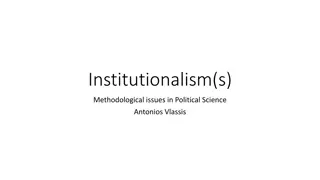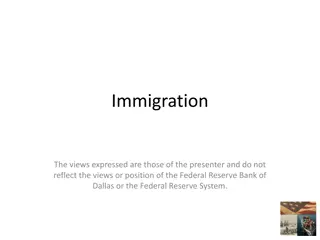Understanding Political Parties and Ideologies in the United States
Exploring the development and dynamics of political parties in the United States, this content delves into the definition of political parties, the two-party system, the political spectrum, major parties' differences, and the roles of Democrats and Republicans. It also touches upon third parties' challenges in presidential elections.
Download Presentation

Please find below an Image/Link to download the presentation.
The content on the website is provided AS IS for your information and personal use only. It may not be sold, licensed, or shared on other websites without obtaining consent from the author. Download presentation by click this link. If you encounter any issues during the download, it is possible that the publisher has removed the file from their server.
E N D
Presentation Transcript
Development of Political Parties A political party is a group of citizens (voters) with similar views on public issues who work to put their ideas into effect through government action and who band together to elect candidates.
Development of Political Parties Parties pick candidates who agree with their beliefs and try to persuade voters to support their candidates who are running for office. The United States today has a two-party system, which means that we have two main political parties.
Political Spectrum Generally, parties are often labeled as liberal or conservative, depending on their views. Parties fall somewhere on the political spectrum (a range referring to differences in political views). Many people fall somewhere in the middle and are known as moderates. They generally lean toward one side or the other. Left Moderate Right Liberal Conservative
Todays Major Parties A basic difference between the major parties is their belief in how much the government should be involved in the lives of Americans.
Democratic Party Democrats are generally said to be more liberal. They favor more government programs that offer services in housing, education, healthcare, and economics. These programs would be funded through taxes.
Todays Major Parties Republicans are generally said to be more conservative. Republicanstend to believe that they can help the nation s economy grow by reducing the amount of taxes that people have to pay. They favor less government regulation of the economy. They are opposed to raising taxes.
Third Parties Although they sometimes challenge the two major parties, a Third Party has never won a Presidential election and has rarely won any other major elections.
Third Parties Third Parties, however, can affect the outcome of elections and may also influence government policy.
Third Parties Third Parties rarely win major elections because of the two-party tradition. For example, while the names of Republican and Democratic candidates are automatically placed on the ballot, Third-Party candidates must obtain a large number of signatures to get on the ballot.
Examples of Third Parties The Communist Party supports the rights of the workers and economic equality.
Examples of Third Parties The Socialist Party supports government ownership/allocation of resources.
Examples of Third Parties The Libertarian Party would like to increase individual freedoms by cutting the size of the U.S. government. According to the Libertarian party, they are more liberal than Democrats, yet more conservative than Republicans.
Party Platforms To know where a party stands on the major issues, voters can look at the party s platform.
Party Platforms A platform is a series of statements expressing the party s principles, beliefs, and positions on issues. Each individual part of a platform is called a plank.
The Issues Federal Platform (Overall Party Concerns) Democratic Party Platform Republican Party Platform Wants to use tax relief to grow economy and create jobs Wants the federal government to place regulations on businesses to influence economic growth Plank 1 (Specific Issue) Unites States Economy Wants to raise standards in K-12 Schools and increase financial aid for secondary education Wants to increase access to charter schools, and promote accountability for students and parents Plank 2 (Specific Issue) Education Mandated healthcare for all citizens Says mandated healthcare is unconstitutional. Supports Medicare Plank 3 (Specific Issue) Health Care Supports industry of creating green energy Wants America to resume off-shore drilling to boost economy and lower Plank 4 (Specific Issue) Energy
Where do they stand on the Economy, Heath Care, Environment, Education???























